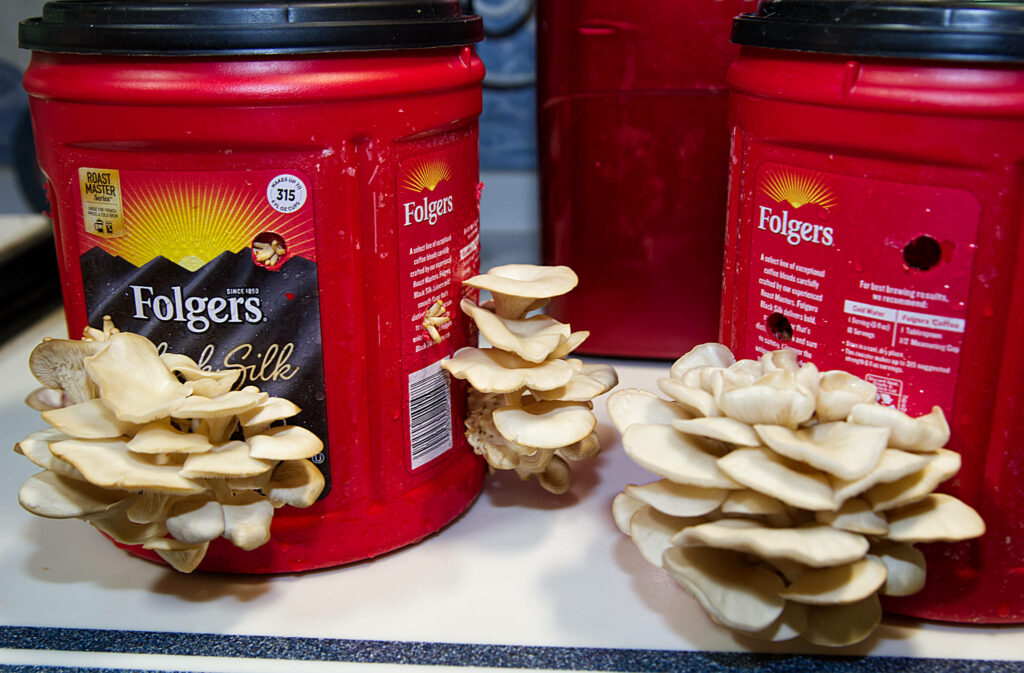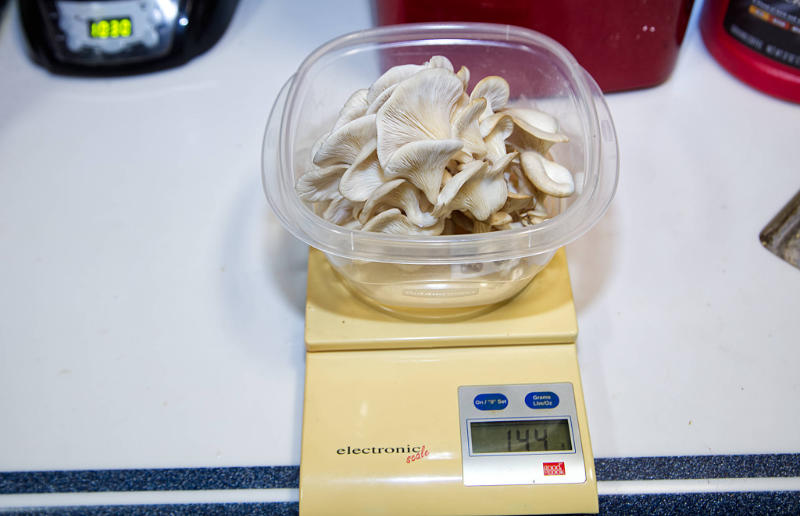Whether you want to grow edible mushrooms at home to provide food for your family, or as a sweet side income, you’ll be able to use what I have learned to help you get started. Although I just got my first harvest of blue oyster mushrooms, I learned a lot about mycology and the mushroom life cycle.
This foundation can help you learn to grow edible mushrooms at home too. You don’t need to be a genius or a mycologist to grow edible mushrooms. But it helps if you have some general knowledge. Since there are tons of resources on the internet, I’m not going to spend a lot of time on that in this article. Just know that the knowledge will be necessary if you decide to get into this as a hobby or small business. I’ll go more in-depth as these articles progress.
Why Would I Want to Grow Edible Mushrooms at Home?

There are many reasons you might want to grow your own edible mushrooms. Prices for everything are skyrocketing, so growing your own food can help you save money.
Mushrooms are full of essential nutrients that your body needs. Mushrooms are high in fiber and protein. They can supply your body with trace minerals that may be lacking in your diet, and they are low in calories. Best of all, they taste great!
They can be a part of your long-term food storage by freezing or drying them for later use. They can be dried for storage by placing them on a rack at low heat in the oven or using a food dehydrator. They can also be frozen by laying them out on a cookie sheet in a single layer and then placing the sheet in the freezer. If you flash freeze them in this way you can place them in bags frozen individually for storage. When you need them for a dish you can easily use just what you need. If you throw them in a bag together before they are frozen they will freeze into a giant frozen mess, since mushrooms are up to 90% water.
What Options Are There for Growing Edible Mushrooms?

In this series of articles, I’ll talk about the different methods to grow edible mushrooms at home and your options for doing so.
The easy method covered below is what many people will most likely opt for. This option is for those who like the taste of fresh mushrooms but don’t have the time or space for a growing setup. However, I will be covering methods you can try that use commonly available equipment that can be found locally or quickly online at little cost. An example of that would be the photo above where I used recycled coffee containers and modified them easily to adapt them to grow oyster mushrooms.
Don’t worry, I’ll cover that in future articles because it is much more involved and time-consuming, and a certain amount of research, knowledge, and skill are required. That’s why I decided to break this article down into several parts as I began writing. Otherwise, it would most likely become cumbersome to read.
The Easiest Method
By far, the easiest method for growing your own gourmet mushrooms at home is to buy a pre-spawned fruiting block in a kit from a supplier. The supplier has already done all the hard work for you. The kit comes in a box with a bag inside that is ready to fruit and produce mushrooms. All you do is sit it on a shelf or counter out of direct sunlight, mist it with water about 3 times a day, and in about a week you can begin harvesting mushrooms ready to cook and eat.
The Harder Method
This process can be both perplexing and exciting, but with the right knowledge and tools, you can successfully grow your own delicious mushrooms.
Step 1: Obtain Liquid Culture
The first step in growing mushrooms is to obtain liquid culture. Liquid culture is a suspension of mushroom mycelium in a liquid nutrient solution. You can purchase liquid culture online or from a local supplier. It is important to ensure that the liquid culture is sterile and free from contaminants.
Step 2: Inoculate the Spawn
Next, you will need to inoculate your chosen spawn substrate with the liquid culture. The spawn substrate is a material that the mycelium will grow on. Popular choices include sterilized grains, sawdust, or straw. You can inoculate the spawn by injecting a small amount of liquid culture into the substrate using a sterile syringe.
Step 3: Incubate the Spawn
After inoculating the spawn, you will need to incubate it at a temperature of around 75-80°F (24-27°C) until the mycelium has fully colonized the substrate. This can take anywhere from a few days to several weeks, depending on the type of mushroom and the substrate used.
Step 4: Prepare the Fruiting Substrate
Once the spawn has fully colonized the substrate, it is time to prepare the fruiting substrate. The fruiting substrate is a material that the mushrooms will grow on and is usually a mix of materials like straw, sawdust, and other nutrients.
Step 5: Inoculate the Fruiting Substrate
Inoculate the fruiting substrate by adding the colonized spawn to the mixture. Mix it thoroughly and put it in a container that has a small hole in it for the mushroom to grow out of.
Step 6: Fruiting
Finally, it is time to fruit the mushrooms. The fruiting process can take several weeks, and it is important to maintain the proper conditions during this time. The ideal temperature for fruiting mushrooms is around 65-70°F (18-21°C), and the humidity should be around 90%. Mist the fruiting substrate with water every day and wait for the mushrooms to appear.
Conclusion
When you grow mushrooms you have a lot of options. The easiest method, and the one many people decide to use, is to purchase a mushroom grow kit online. If you don’t have a lot of time, this method can allow you to harvest fresh mushrooms with minimal effort. Just a small space on a shelf or counter out of direct sunlight is all you need. Just follow the directions that come with the kit, and soon you’ll have a bounty of tasty, fresh mushrooms.
In the next article, I’ll begin covering my experiments and the results of how I began growing edible mushrooms at home. I’ll continue to post updates as I find new methods and learn new tricks. I hope you will follow along on this journey into the cultivation of edible mushrooms at home.
Be sure and check out all the informative articles on our Natural Living Blog.
FAQs:
Q: Is it easy to grow edible mushrooms at home?
A: Yes, growing edible mushrooms at home is relatively easy and can be done by anyone with a little bit of knowledge and the right tools.
Q: What edible mushrooms can you grow yourself?
A: Some of the most popular edible mushrooms that you can grow at home include button mushrooms, oyster mushrooms, shiitake mushrooms, and lion’s mane mushrooms.
Q: Can you grow edible mushrooms in your backyard?
A: Yes, you can grow edible mushrooms in your backyard as long as you have a suitable spot with the right growing conditions.
Q: Is it worth it to grow your own mushrooms?
A: Growing your own mushrooms can be very rewarding, both in terms of the satisfaction you get from growing your own food and the money you can save by not having to buy mushrooms at the grocery store.
Q: Do mushrooms continue to grow after picking?
A: No, once a mushroom is picked, it will not continue to grow.
Q: What is the most profitable mushroom to grow indoors?
A: There are several profitable mushrooms that can be grown indoors, but one of the most popular and lucrative is the shiitake mushroom.
Q: Do mushroom growers make good money?
A: Yes, mushroom growers can make good money, especially if they focus on high-demand, high-value varieties like shiitake and oyster mushrooms.
Q: Which mushroom has the highest demand?
A: The mushroom with the highest demand varies depending on the region, but generally, button mushrooms and shiitake mushrooms are among the most popular.
Q: What state is best for mushroom farming?
A: The best state for mushroom farming depends on the specific type of mushroom being grown, but some states with a thriving mushroom industry include Pennsylvania, California, and Oregon.